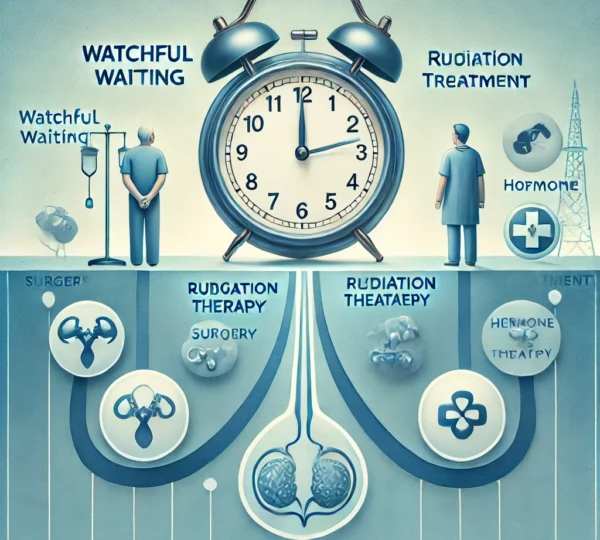Time and Treatment: Navigating Prostate Cancer’s Waiting Game and Survival
Introduction: Unveiling the Clockwork of Prostate Cancer
Prostate cancer is the second most common cancer among men, following skin cancer. While this disease often grows slowly, its complexities demand careful management and timely treatment. For those diagnosed, the question becomes: How much time is too much when it comes to treating prostate cancer? Delaying treatment might seem harmless at first, but its impact can be profound. Understanding the role of time in prostate cancer survival is critical to making informed decisions.
Understanding Watchful Waiting and Active Surveillance
What Is Watchful Waiting?
Watchful waiting involves monitoring prostate cancer without immediate treatment. This approach is typically chosen for low-risk cancers, where the tumor is small and grows slowly. Doctors closely observe the cancer’s progression through regular exams, blood tests, and biopsies.
Watchful waiting avoids the side effects of treatments like surgery or radiation, making it an option for men who may not need immediate intervention.
What Is Active Surveillance?
Active surveillance, though similar to watchful waiting, involves more frequent testing and assessments. This strategy is typically used for intermediate-risk prostate cancer, where there may be some signs of cancer growth but no urgent need for immediate treatment. Men under active surveillance will often undergo more regular biopsies, imaging tests, and blood work. The goal is to catch any signs of cancer progression early and begin treatment if necessary, while still avoiding aggressive treatments unless they’re required.
The Impact of Waiting on Prostate Cancer Survival
How Delayed Treatment Affects Survival
Recent studies, including research published in the Journal of the American Medical Association, have revealed concerning information about waiting to treat prostate cancer. Men who delayed treatment for prostate cancer had a significantly higher risk of dying from the disease compared to those who started treatment sooner.
Specifically, the risk of mortality related to prostate cancer increased by 10% for each year of treatment delay. This highlights how important it is to balance the need for observation with timely intervention.
Why Time Matters in Prostate Cancer Treatment
Prostate cancer is notorious for its slow-growing nature, which often leads to the mistaken belief that waiting won’t have significant consequences. However, delaying treatment can allow the cancer to grow and spread. As time passes, prostate cancer cells may acquire mutations, making them more aggressive and resistant to treatment. This increase in aggressiveness further complicates the situation, potentially leading to more advanced cancer that’s harder to treat effectively.
How Waiting Can Make Cancer More Aggressive
The Risks of Delaying Treatment
When prostate cancer is left untreated or under-monitored for too long, it can behave unpredictably. The cancer may not only continue growing in size, but it could also spread to other parts of the body, such as the lymph nodes or bones. Additionally, cancer cells may adapt and become more aggressive over time, making treatment options less effective. The longer a man waits, the more difficult it becomes to manage the disease with traditional therapies.
Another potential risk of waiting is the cancer’s ability to become resistant to medications. In advanced stages, prostate cancer can develop resistance to common therapies such as hormone therapy, making it more challenging to control. Therefore, while watchful waiting and active surveillance are viable options, careful monitoring and timely intervention are key to preventing the cancer from worsening.
Treatment Options Beyond Waiting
Exploring Your Choices
While waiting may be an option for some men with prostate cancer, there are other treatment avenues that can help manage or cure the disease. Deciding when to begin treatment depends on factors such as the cancer’s stage, its risk level, and the patient’s overall health. Let’s look at the most common treatment options:
- Active Surveillance: This option continues to monitor the cancer closely, and if the cancer shows signs of progression, treatment will begin. It’s a personalized approach that allows for timely interventions.
- Surgery: The most common surgical treatment for prostate cancer is prostatectomy, where the prostate gland is removed. This can be a curative option for patients with localized cancer, and many men recover fully after surgery. However, surgery carries risks, including incontinence and erectile dysfunction.
- Radiation Therapy: Radiation therapy uses high-energy rays to target and destroy cancer cells. It can be used to treat localized prostate cancer or shrink larger tumors. There are different types of radiation, including external beam radiation and brachytherapy (internal radiation).
- Hormone Therapy: Prostate cancer is often fueled by testosterone, and hormone therapy aims to lower testosterone levels or block its effects. This can slow down cancer growth or shrink existing tumors. Hormone therapy is commonly used in advanced prostate cancer cases.
- Chemotherapy: In advanced stages where cancer has spread, chemotherapy may be recommended. Chemotherapy involves drugs that kill cancer cells throughout the body, and it is typically used when other treatments are no longer effective.
online pharmacy buy clomid no insurance with best prices today in the USA
Conclusion: Making the Right Choice for Prostate Cancer Treatment
Choosing the Right Path
Deciding how and when to treat prostate cancer is not a decision that should be made lightly. The key factors to consider include the cancer’s stage, your general health, and personal preferences. Treatments like surgery and radiation therapy are often considered when cancer is more advanced, while options like watchful waiting or active surveillance might be appropriate for lower-risk cases.
Having an open discussion with your healthcare provider is essential. Your doctor will help you understand your individual risk factors and recommend the best course of action. It’s crucial to balance the potential benefits of early treatment with the risks of aggressive therapies. With careful consideration and medical guidance, you can make the right decision for your health and wellbeing.
For More Information Click here



